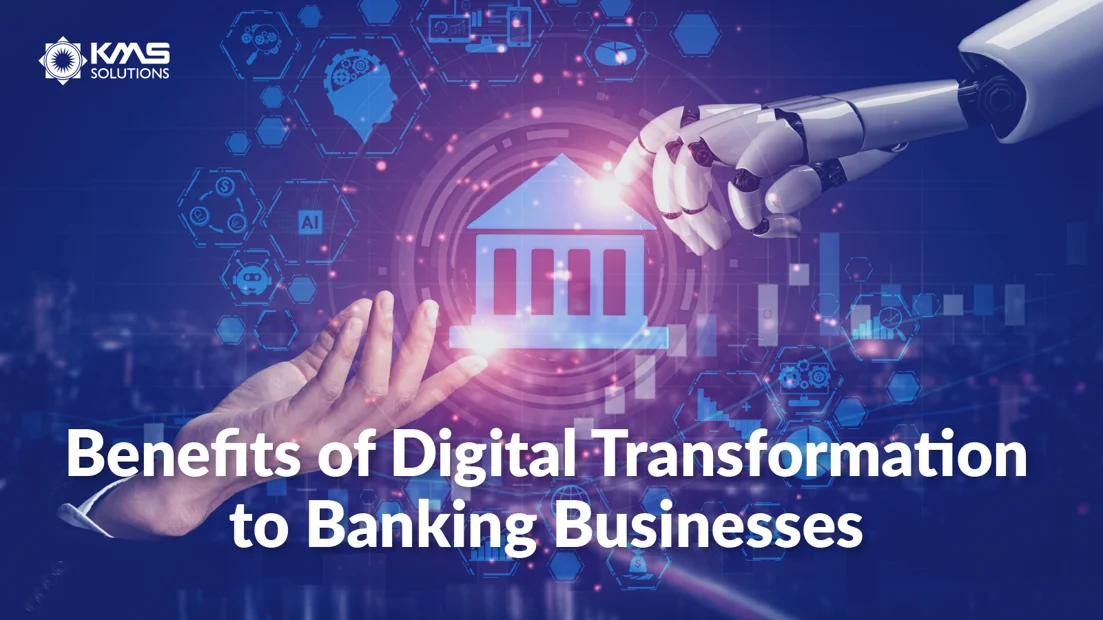Banking is notorious for being slow in Digital Transformation when compared to other more agile sectors such as Retail and eCommerce. This harsh reality is especially true for incumbent banks. Their complex and long-standing core require substantially more time and resources. Plus, the fixed mindset of the workforce usually rejects a thorough revolution like Digital Banking. Instead, they prefer a more gradual change.
Reportedly, Digital Transformation in the banking sector is still responsive. When banks launch digital initiatives, it’s mostly a response to major market trends and shifts in customer behavior that leave them with no choice but to change. Mobile Banking or electronic Know-your-Customer (KYC) are prime examples.
However, as more market challengers like fintech and neo-banks entered the banking scene, we can expect to see more success stories of Digital Transformation in Banking.
The benefits of Digital Transformation can differ slightly from bank to bank. But in general, there are some common advantages to consider, which we will make clear in this article.
Process Automation
Leading banks are combining Artificial Intelligence (AI), Robotic Process Automation, and Process Orchestrator into what’s called Intelligent Banking Automation (IBA). By allowing all repetitive, rule-based manual workflows to be automated, therefore minimizing unnecessary human interventions, IBA is the automated future of the Banking industry.
Today, banks are also investing hugely in an effort to combine their automation capabilities with data analytics and human creativity. The result is advanced automation where, across the business, complex issues are automatically resolved, deep insights are generated, and new service ideas are generated.
There is an abundance of areas where IAB can be applied, both in the customer-facing front and in the back-office operations: Budget Transfer Approval, Reconciliation, Income Processing, Data Upload, Account Opening.
With IAB, banks can:
- Accelerate speed of operational processes
- Reduce cost and improve quality
- Improve employee experience
- Enhance customer research and highly target marketing
- Easily satisfy changes to regulations
Advanced use of Data Analytics
Data Analytics is nothing new for bankers. Quite the contrary. Banking has always been pioneering in innovations related to data analytics. Beyond data processing, data visualization, and data warehousing, the applications of data and advanced analytics solutions in banking have become numerous. Some notable ones include customer analytics and risk. The other ones that are being improved are finance, workforce, and supply chain.
Banks are now leveraging data analytics into every part of their businesses, enabling them to:
- Track customer actions and their spending patterns
- Improve customer segmentation based on customer data
- Have a better understanding of risk exposures to improve risk management
- Support offering personalization
- Respond proactively to customer feedback, thereby improving customer service
Banking data falls under the category of Big Data, as it’s only natural for a bank to process thousands to millions of transactions on a day-to-day basis. In these mountains of data is the nearly unlimited potential for insights into their operations, customers, and the market as a whole. Therefore, it’s essential for banks to have a comprehensive strategy for data analytics – one that allows them to utilize both internal and external data, whether they are in structured, semi-structured, or unstructured form.
Better Customer Experience
When setting out on Digital Transformation for Banking Sector, most banks would put “customer experience” first in their agenda. In Banking, customer experience is the combination of all experiences when interacting with banks through different touchpoints. These include online banking systems, call centers, emails, online advertising, and even social media.
To enhance customer experience, most banks are applying these strategies:
- Developing customer-centric mobile app: for banks, mobile banking applications have become a must. The new generation of customers demands to access banking services from anywhere, and at any time. Developing multi-purpose and user-centric mobile applications, banks find it easier to attract and engage customers while still being able to reduce operational costs.
- Electronic Know-your-Customer (eKYC): a great first impression would largely determine how great an entire customer experience. For most banks, this first impression happens during customer onboarding. While in the past, onboarding required customers to fill piles of papers and wait in long lines at the banks, which is time-wasting and troublesome. Now thanks to eKYC, banks can digitize the onboarding process, thereby eliminating much of the paperwork involved, reducing costs, and improving customer experience.
- Hyper-personalization: Whereas traditional personalization applies predictive analytics to tailor products and messaging to a specific segment of customers, hyper-personalization focuses on the individual customer. It’s a combination of predictive analytics, AI, and machine learning so that banks can offer hyper-targeted, one-on-one products and marketing messages.
The Digital Core
Instead of holding on to monolithic core systems that are dragging them down, banks are applying dynamic APIs to enable composable banking – i.e. the idea of decomposing core banking systems into independent components, each having a best-for-purpose functionality. Composable banking holds phenomenal potential. It helps banks digitize their very core. What’s more? Thanks to it, banks can become as agile and nimble as fintech start-ups, where they are able to plug in and plug out new functionalities without causing disruptions to their architecture.
Composable banking brings old banks the best of both worlds. On the one hand, banks have the agility of fintech. And on the other, they still remain the advantages of the incumbents, in terms of data security, fraud management, and credibility.
Composable banking brings benefits such as:
- Improved agility: Thanks to composable banking, banks can combine, separate, and then re-combine new functionality when needed.
- Faster Speed to market: new products now can be deployed in a matter of a few months.
- The reduced total cost of ownership: composable banking allows developers to increase their productivity and decrease technical debts.
- Better customer relationships: Banks can now focus attention more on the front-end experience and less on the back-end tech stack.
If you want to learn more about Digital Banking Roadmap and how your banks can embrace this revolution, subscribe to our Newsletter.










